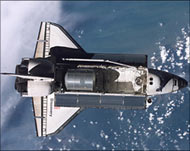Nasa to unveil moon-visit plans
With the shuttle fleet grounded and the International Space Station staffed by a skeleton crew, Nasa is set to unveil plans to take people and cargo to the moon.

Despite criticism from Capitol Hill on Monday over the reported $100 billion cost of the lunar programme, the plan is to get astronauts back to the moon for the first time since the Apollo 17 mission in 1972.
One team of designers has envisioned an Apollo-style capsule sitting atop rockets fashioned from shuttle components, including the shuttle’s massive external tank and solid rocket boosters.
There would be a separate space vehicle to carry only cargo.
The Space.com website reported that this scenario was presented to White House officials last week before its formal unveiling to the public on Monday.
Scepticism
The new $100 billion lunar programme would begin in 2018 by landing four people on the moon for a seven-day stay.
President George Bush’s plan to send Americans back to the moon by 2020 and eventually on to Mars has drawn scepticism since its unveiling in January 2004, less than a year after the 1 February 2003 shuttle Columbia disaster.
 |
|
Nasa aims to replace its ageing |
Bush’s Vision for Space Exploration called for the development of a system to replace the aging shuttles, a goal that appears more important given problems with the shuttle fleet’s return to flight.
The same problems with falling debris that doomed Columbia recurred in July with the launch of Discovery, prompting the grounding of the shuttle fleet.
A September shuttle mission was delayed until November and then to March. About $1.1 billion damage by Hurricane Katrina to Nasa facilities in Louisiana and Mississippi could push the launch date back further.
Space station delay
Bush’s plan also mandated the completion of the International Space Station, but without shuttles to do the heavy lifting, that process has been on hold.
A pair of Russian vehicles – the space taxi Soyuz and the space delivery van Progress – have been ferrying people and material.
Since the fatal Columbia disaster, only two-person crews have stayed aboard the station, rather than the normal three-person crew.
With the shuttles slated for retirement in 2010, Nasa Administrator Michael Griffin has estimated that the number of construction flights to the station could be pared to 15 from its earlier estimate of 28.